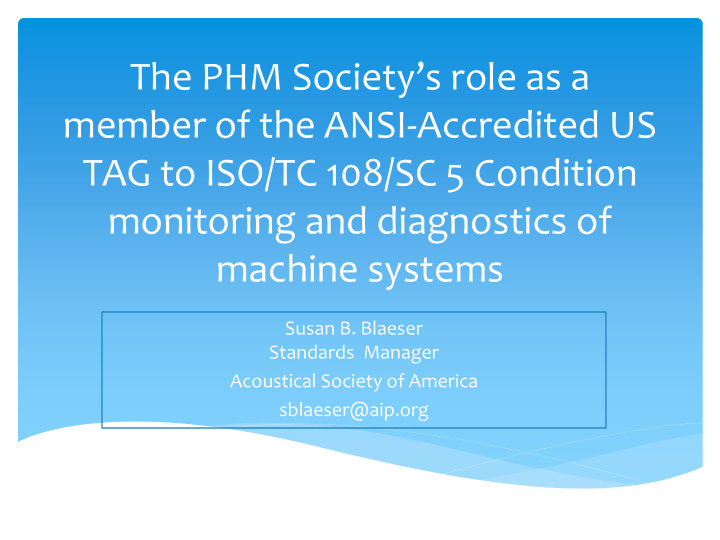



The PHM Society’s role as a member of the ANSI-Accredited US TAG to ISO/TC 108/SC 5 Condition monitoring and diagnostics of machine systems Susan B. Blaeser Standards Manager Acoustical Society of America sblaeser@aip.org
Plan for this talk ISO/TC 108 context for SC 5 Intro to ISO/TC 108/SC 5 (scope and body of work) Steps in the ISO standards development process What is the U.S. TAG? Why should an organization join the TAG? What does the TAG actually do? What does “voluntary consensus standards” mean?
ISO/TC 108/SC 5 Condition monitoring and diagnostics of machine systems Standardization of the procedures, processes and equipment requirements uniquely related to the technical activity of condition monitoring and diagnostics of machine systems in which selected physical parameters associated with an operating machine system are periodically or continuously sensed, measured and recorded for the interim purpose of reducing, analyzing, comparing and displaying the data and information so obtained and for the ultimate purpose of using this interim result to support decisions related to the operation and maintenance of the machine system.
The members of ISO/TC 108/SC 5 P Members (22): Australia (SA), Belgium( NBN), Canada (SCC), China (SAC), Czech-Rep. (UNMZ), Denmark (DS), Egypt (EOS), Finland (SFS), France (AFNOR), Germany (DIN), India (BIS), Ireland (NSAI), Japan (JISC), Rep. of Korea (KATS), Nigeria (SON), Norway (SN), Portugal (IPQ), Russian Federation (GOST R), Sweden (SIS), Switzerland (SNV), United Kingdom (BSI), USA (ANSI). O Members (11): Argentina (IRAM), Austria (ASI), Brazil (ABNT), Hong Kong, China (ITCHKSAR), Italy (UNI), New Zealand (SNZ), Pakistan (PSQCA), Romania (ASRO), Slovakia (SUTN), South Africa (SABS), Spain (AENOR).
Overview Training & CM&D Techniques Vocabulary Assessment Vibration (SC 2) CM&D general Vibration Tribology guidelines Tribology Acoustic emissions Acoustic emissions Thermography Thermography Ultrasound Requirements for Ultrasound training & assessment bodies Data processing, communication & presentation Diagnostics Prognostics General guidelines General Guidelines Data-driven app. Performance based Application specific Knowledge-based Cyclic driven life Structures (TC) Performance usage Three-phase monitoring & Useful life remaining induction motors diagnosis prediction models Power transformers Vibration (SC 2) Wind turbines
Steps in the ISO process New work item proposal (NP) Bottom-up process – idea comes from the technical community Working group is formed – expert members appointed by each country Working draft (WD) Committee draft (CD) * Draft International Standard (DIS or CDV) Final Draft International Standard (FDIS) * Systematic Review (SR) * Stage is now optional at the committee’s discretion
What is the U.S. TAG to ISO/TC 108/SC 5? The U.S. TAG is the only avenue for U.S. stakeholders to have a voice in ISO standards development. No opportunity for direct organizational membership in ISO. ANSI is the sole U.S. voter in ISO -- the TAG tells ANSI how to vote. All U.S. TAGs are formed in ANSI’s name but…they are organized, managed and funded by the U.S. TAG Administrator organization. This TAG is administered by the Acoustical Society of America which also provides the International Secretariat for SC 5.
Why is it important for an organization to join the U.S. TAG? To influence the content of relevant standards. To monitor future changes (advance intelligence). To promote harmonization among international standards, national standards and industry standards. To ensure that products can be exported worldwide. To minimize the need for government regulation. To establish the leadership position of your organization. To network with other experts in your field.
What does the U.S. TAG do? At each voting stage, we announce the availability of the document to the U.S. TAG members. The announcement includes the scope of the document, the voting deadlines, and instructions. Members who want to review the document opt-in. If you opt-in, you are expected to reply, even if only to abstain or say yes with no comments. You should participate even if you are on the WG.
What does the term “voluntary consensus standards” mean? ISO standards are not law. Use of a standard is generally voluntary. Consensus implies General agreement Involvement of stakeholders All views are considered Effort to resolve objections Consensus need not imply unanimity
Who’s in the TAG Acoustical Society of America National Institute of Standards & Technology American Industrial Hygiene Assoc. NIOSH Ariel Corporation PCB Group Association of American Railroads PHM Society BP America Power Tool Institute Calnetix Schenck Trebel Corp Caterpillar Shock & Vibration Exchange Commercial Vehicle Group Siemens Power Generation, Inc. Condition Analyzing Corp. Sinclair PLLC Duke Univ. Dept. of Biomedical Engineering UE Systems Eckardt Johanning, MD, PC University of Washington Emerson Electric US Air Force Endevco US Army Aeromedical Research Lab General Electric US Army Center for Health Promotion Infrared Training Center US NSWC- Carderock International Council for Machinery Lubrication US NSWC- Panama City John Deere USDOT - Volpe Ctr. Marketing Assessment, Inc. Vibration Institute Mechanical Solutions, Inc. V-Tek Associates, LLC MIMOSA Waukesha Magnetic Bearings NASA Ames Research Center
Thank you! Susan Blaeser sblaeser@aip.org +1 631-390-0215 Visit our website http://acousticalsociety.org/standards / Visit www.standardsboostbusiness.org to see case studies and learn more about the value of direct participation in the development of standards that affect your business.
Recommend
More recommend